In today's article, we will tell you about the 5 major tribes of Uttarakhand, which are identified by the Government of India in Uttarakhand. In the previous article, we had given you information about the major tribes of India.
The total population of Uttarakhand is 1,00,86,292, of which the Scheduled Tribe population is 2,91,903.
The percentage of Scheduled Tribes in the state is 3% of the total population.
According to the 2011 census, the literacy rate of Uttarakhand state is 79.9%, out of which the male literacy rate is 86.3% and the female literacy rate is 63.9%.
How many neighboring countries of India - List
Top 10 most populated countries in the world
5 Major Tribes of Uttarakhand
Many tribes live in Uttarakhand. In this article, we are going to tell you about the 5 major tribes of Uttarakhand which are as follows - Tharu, Bhotiya, Buksa, Jaunsari, and Raji.
Tharu, Bhotiya, Buksa, Jaunsari, and Raji residing in Uttarakhand were declared Scheduled Tribes in the year 1967.
The Buksa and Raji tribes are economically, educationally, and socially very poor and backward in comparison to other tribes, they are placed in the category of the primitive tribal group.
Let us know in detail about the major tribes of Uttarakhand.
1. Tharu Tribe of Uttarakhand
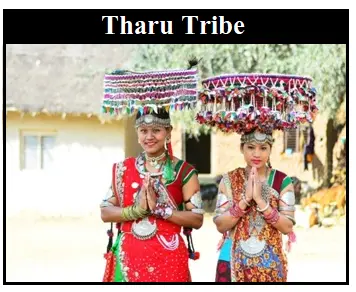
- The Tharu tribe is the largest tribal group in Uttarakhand.
- Tharu tribe mainly resides in India and Nepal.
- These tribes live in the lowland regions of India and Nepal.
- The largest population of the Tharu tribe is in the UdhamSingh Nagar district of Uttarakhand.
- In India, this tribe lives in the states of Uttarakhand, Uttar Pradesh, and Bihar.
- The Tharu tribe is the largest tribe in the Kumaon division of Uttarakhand.
- In Uttarakhand, their population is mainly concentrated in Sitarganj tehsil of Nainital and Khatima tehsil of Udham Singh Nagar.
- In Uttar Pradesh, this tribe lives in Lakhimpur, Bahraich, Gorakhpur, Gonda, and Kheri districts.
- In Bihar, this tribe lives in the Champaran district.
- The word 'Tharu' is believed to be derived from 'Sthavira' which means a follower of the Theravada branch/tradition of Buddhism.
- According to another belief, the Tharu tribe is named after the Thar desert of Rajasthan, because the Tharu tribe living in the western lowland considers itself to be a descendant of the Rajputs of Rajasthan.
- Anthropologists consider them to be Mongolian, while according to some they are of Kirit descent.
- The people of the Tharu tribe mainly believe in Hinduism and worship Hindu gods and goddesses, while some people also believe in Buddhism.
- This tribe is dependent on farming, fishing, and hunting for survival.
- Due to their high immunity to fight against malaria, they are also called 'malaria-proof humans'.
- Patriarchal tradition is found in the Tharu tribe, but the importance of women is also not less than that of men.
- The main festivals of the Tharu tribe are Holi, Deepawali, Dussehra, Ganga-snana etc.
- People of the Tharu tribe consider Deepawali as mourning because on this day these people remember their ancestors and mourn in their memory.
- In addition to their Tharu languages, the Tharu caste speaks Nepali, while some regional Bhojpuri, Maithili, and Awadhi languages are also spoken.
- People of the Tharu community worship Lord Shiva as Mahadev and they use the word 'Narayan' as their surname, they believe that Narayan is the provider of sunshine, rain, and harvest.
- The two main dishes of the Tharu community are 'Bagiya' or 'Dhikri' and 'Ghongi'. Bagiya (Dhikri) is a dish of boiled rice flour, which is eaten with chutney or salan.
- In Bihar, Tharu of West Champaran celebrates a festival called Barna. At the beginning of Barna, the people of Tharu society perform puja in a grand manner, and at the end of it, there are a lot of traditional songs, music, and dance. After, this they do not come out of their homes for 60 hours.
- Jhumda and Lahchari are the main dance songs of the Tharu tribe.
- National Symbols of India: Flag, Anthem, Animal, Bird
- All-State and Capital: Indian State and Capital list
2. Jaunsari Tribe of Uttarakhand
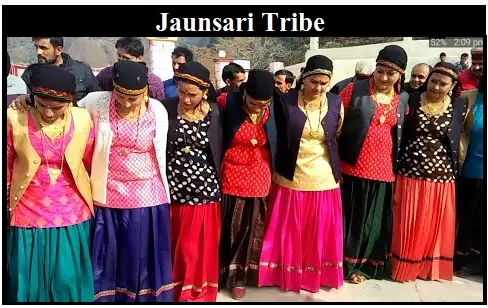
- Jaunsari tribe is the second largest tribal group in Uttarakhand.
- Jaunsari tribe is the largest tribe in the Garhwal division of Uttarakhand.
- The maximum population of the Jaunsari tribe is in the Dehradun district of Uttarakhand.
- Jaunsari tribe mainly resides in Chakrata, Kalsi, and Tuni tehsil of Dehradun district of Uttarakhand.
- The area of Chakrata, Kalsi, Tuni Lakhamandal is known as Jaunsar Bawar. This area is situated between Yamuna and Tons rivers.
- The Jaunsari tribe is believed to be a descendant of the Khas caste.
- Socially there are two major areas of Jaunsar-Bawar in which two major communities reside. The lower half is 'Jaunsar' and the upper half is ‘Bavar'.
- The people of the Jaunsar tribe consider themselves to be the descendants of Pandavas, who are known as Pashi and the people of Bawar consider themselves to be descendants of Duryodhana, who is called Shathi.
- The Jaunsari tribe is probably the only tribe in India, which was given tribal status in 1967 on the basis of economic and backwardness.
- The main festivals of the Jaunsari tribe are Nunai, Bissau, Magh Mela, Deepawali, Dussehra, etc.
- There is a tradition of polyandry in the Jaunsari community.
- Jaunsari people worship MahasuDevta.
- The main sources of employment in this sector are agriculture and animal husbandry.
- The main folk dances of this tribe are 'Barda Nati' and "Harul".
- The most important festival of Jaunsari is 'Magh Mela'.
- Why do clouds appear white?
- Why is the sky blue?
3. Buksa Tribe of Uttarakhand
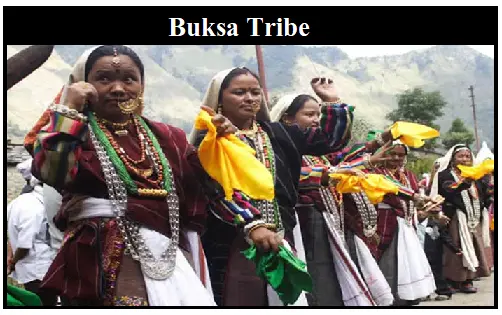
- Buxa or Boxa tribe is the third largest tribal group of Uttarakhand.
- The population of the Buksa tribe in Uttarakhand is about 46,771 whereas in Uttar Pradesh their population is about 4,367.
- People of the Buksa tribe speak the Buksa language.
- The largest population of the Buksa tribe is in Udham Singh Nagar. Apart from this, the Buksa tribe is found in Dehradun, Haridwar, Nainital, and Pauri Garhwal.
- Apart from this, the Buksa tribe is also found in Bijnor of Uttar Pradesh where they are known as Khas.
- Chamunda Devi is the main deity of the Buksa tribe.
- For the upliftment of this tribe, Boxa Parishad has also been established in Nainital and Udham Singh Nagar.
- Chaiti is the main festival and fair of the Buksa tribe.
- Hongan, Delya, Gotre, Naubi, More, etc. are the major festivals of the Buksa tribe.
- The international airport in India
- What is Indian Currency?
4. Bhotiya Tribe of Uttarakhand
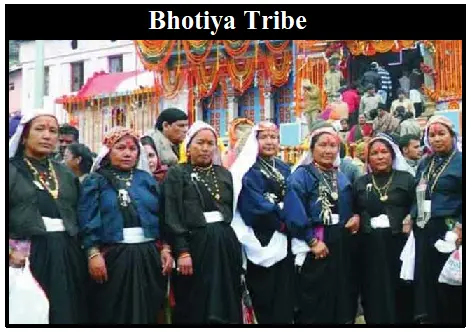
- The Bhotiya tribe is the fourth largest tribal group in Uttarakhand.
- The largest population of the Bhotiya tribe is in the Pithoragarh district. Apart from this, the Bhotia tribes live in Pithoragarh, Chamoli, Nainital, Uttarkashi, Bageshwar, Almora, Champawat, and Rudraprayag.
- The Bhotiya tribes residing in Pithoragarh are called Jauhari and Shauk.
- The Bhotiya tribes living in Chamoli are called Marchha and Torchha.
- The people of the Bhotiya tribe of Uttarkashi are called Jaar. Jaar people consider themselves descendants of Janaka.
- The Bhotiya people have been identified as Raghuvanshi Rajput and they consider themselves Thakur or Rajvanshi.
- The summer residence of the Bhotiya tribe is called Mait.
- The winter residents of the Bhotiya tribe are called Munsa.
- The main occupation of the people of the Bhotiya tribe is agriculture, animal husbandry, and trade.
- People of the Bhotiya tribe celebrate a festival called 'Kandali' every 12 years.
- Pauna dance is performed by the Bhotiya tribe on the occasion of marriage.
- Tuvera, Bajyu, Timli, etc. are the major folk songs of the Bhotiya tribe.
- All Country Currency
- What is Earth and what is the diameter of the earth
5. Raji Tribe of Uttarakhand
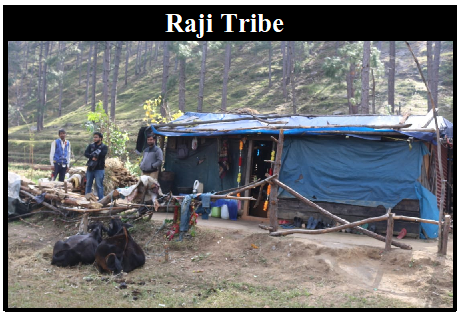
- The Raji tribe is the smallest tribal group in Uttarakhand.
- The highest population of the Raji tribe is in Pithoragarh.
- The Raji tribe is a primitive tribe that lives in the forests.
- This tribe of Uttarakhand has the lowest literacy rate.
- The main festivals of the Raji tribe are Karka Sankranti and Makar Sankranti.
- The Raji tribe is also called Vanrawat.
- The chief deity of the Raji tribe is Baghnath.
- In this tribe, the place where a person dies is abandoned.
- Many people of this tribe are still living a nomadic life while some people have started doing Jhum cultivation.
- The Raji tribe of Uttarakhand is known for its wooden crafts.
- What are the layers of the earth
- What are the seven continents
Important facts about tribes of Uttarakhand
- Most tribal districts in Uttarakhand - Udham Singh Nagar
- Lowest tribal district in Uttarakhand - Rudraprayag
- Most populated tribe of Uttarakhand - Tharu tribe
- Second most populous tribe of Uttarakhand - Jaunsari
- The most backward tribe in Uttarakhand - the Raji tribe
- Which tribe people consider Pandavas as their ancestors - the Jaunsari tribe
- Number of seats reserved for Scheduled Tribes in Uttarakhand Legislative Assembly = 2 (Chakrata and Nanakmatta)
- The summer residence of the Bhotiya tribe is called: Mait
- The winter residence of the Bhotia tribe is called: Munsa or Gunda
- A major deity of the Jaunsari tribe: Mahasu Devta (Shiva)
- Which tribe people celebrate Deepawali as mourning: Tharu tribe
- The food given after widow marriage in the Tharu tribe is called: Lathbharta food
- The List of Indian Prime Minister
- Top 10 Highest Mountains in the World
The district-wise population of Scheduled Tribes in Uttarakhand
According to the 2001 census, the total population of Scheduled Tribes in the districts of Uttarakhand is as follows.
|
Sr.
|
District
|
total population
|
Details of Scheduled Tribes in Total Population
|
|
Raji
|
Tharu
|
Bhotiya
|
Buksa
|
Jaunsari
|
|
1
|
Rudraprayag
|
186
|
0
|
0
|
186
|
0
|
0
|
|
2
|
Tehri Garhwal
|
691
|
0
|
0
|
0
|
0
|
691
|
|
3
|
Champawat
|
742
|
126
|
0
|
616
|
0
|
0
|
|
4
|
Almora
|
878
|
0
|
0
|
878
|
0
|
0
|
|
5
|
Pauri Garhwal
|
1500
|
0
|
0
|
0
|
1500
|
0
|
|
6
|
Bageshwar
|
1943
|
0
|
0
|
1943
|
0
|
0
|
|
7
|
Uttarkashi
|
2685
|
0
|
0
|
2685
|
0
|
0
|
|
8
|
Haridwar
|
2884
|
0
|
0
|
0
|
2884
|
0
|
|
9
|
Nainital
|
4981
|
0
|
0
|
2037
|
2944
|
0
|
|
10
|
Chamoli
|
10484
|
0
|
0
|
10484
|
0
|
0
|
|
11
|
Pithoragarh
|
19279
|
556
|
0
|
18723
|
0
|
0
|
|
12
|
Dehradun
|
99702
|
0
|
0
|
2855
|
22508
|
74339
|
|
13
|
Udham Singh Nagar
|
110174
|
0
|
82790
|
0
|
27384
|
0
|
|
total population
|
256129
|
682
|
82790
|
40407
|
57220
|
75030
|
Read this also




